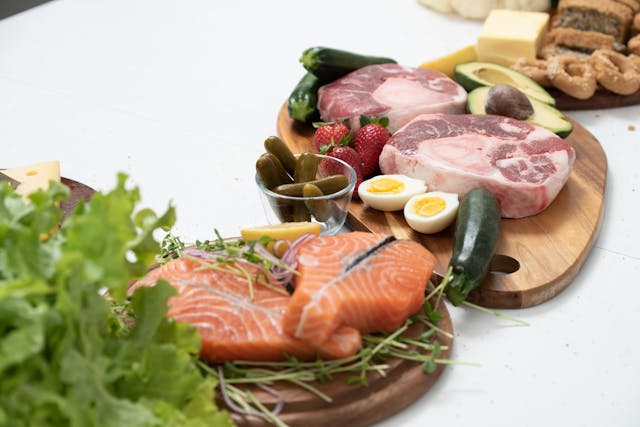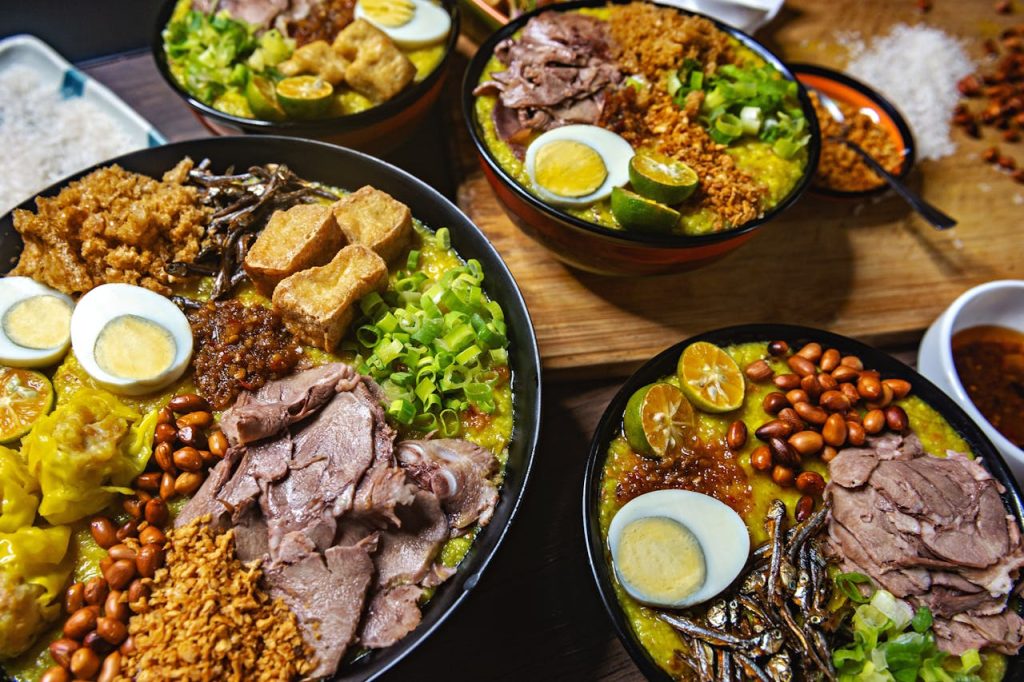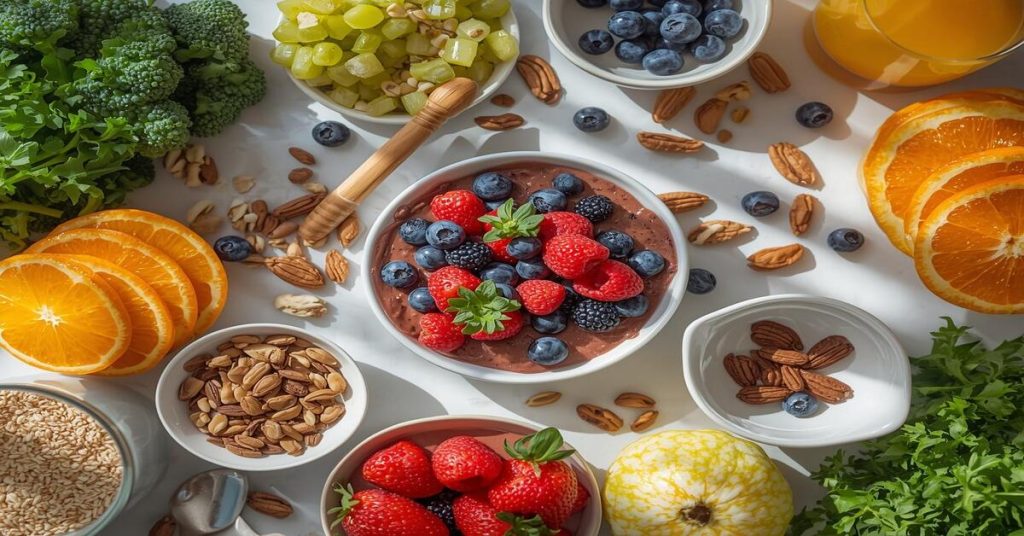5 Power‑Packed High‑Protein Foods You Should Eat Every Day 🚀 (Wellness-Friendly Guide)

Why this matters: Smart protein choices help you feel full longer, stabilize energy, and support a healthy lifestyle—without fad rules. This guide shows you exactly how to use everyday high-protein foods in simple, tasty ways.
At a Glance: What You’ll Get 🎯
- Handpicked list of 5 everyday high-protein foods you can eat daily—animal & plant options.
- Portion cues, flavor ideas, and time-saving prep tips for busy routines.
- One-day sample menu + weekly swap ideas so meals never get boring.
- SEO‑friendly, AdSense‑safe content with natural use of the focus keyword.
Why Protein Deserves a Daily Spot on Your Plate ⚖️
Protein is more than “gym fuel.” It’s the backbone of satiety, steady energy, and better food decisions throughout the day. When you plan meals around everyday high-protein foods, you naturally crowd out ultra‑processed snacks, stabilize cravings, and feel satisfied after meals. Practically, that means fewer afternoon slumps, fewer late‑night pantry raids, and more consistent wellness wins. 💪
Another big benefit: protein pairs beautifully with fiber (veggies, legumes, whole grains). The duo slows digestion, eases blood‑sugar spikes, and keeps your mood and focus on track. That’s real‑life nutrition—simple, repeatable, and delicious.
How to Use This Guide (So It Sticks) 📌
Pick three of the five foods below and rotate them through your day—breakfast, lunch, dinner, or snacks. Repeat weekly with small twists in spices, herbs, and textures. This turns everyday high-protein foods into a ritual you enjoy, not a rule you dread. Keep prep easy: batch‑cook, pre‑portion, and keep add‑ons (like spices, lemon, olive oil, fresh herbs) in one “flavor box.”
Read more: 7-Day Clean Eating Meal Plan for Beginners to Boost Energy Naturally
Discover the 5 Best Everyday High‑Protein Foods for All‑Day Energy 💪 🍽️
Let’s break down the five MVPs. Each section explains why it helps, easy ways to eat it, and simple portion cues you can eyeball. Keep it flexible—swap based on your taste, budget, and availability.
1) Eggs 🍳 — Tiny, Versatile, Satisfying
Eggs are the definition of everyday high-protein foods: affordable, fast, and endlessly adaptable. Start your morning with boiled eggs, a veggie omelet, or scrambled eggs folded with spinach and tomatoes. For lunch, slice a boiled egg over a salad; for a snack, pair one egg with fruit or whole‑grain toast. Eggs also shine in rice bowls and wraps, giving you steady fullness. If you’re short on time, batch‑boil 6–8 eggs on the weekend and keep them in the fridge for grab‑and‑go structure all week. Season creatively—smoked paprika, chili flakes, or za’atar—to avoid flavor fatigue. Portion cue: 1–2 eggs per meal for most people fits easily into a balanced plate.
2) Greek Yogurt 🥣 — Creamy Protein with Gut-Friendly Edge
Thick, tangy Greek yogurt brings protein, calcium, and a naturally satisfying texture that tames cravings. Make a 2‑minute breakfast bowl: Greek yogurt + berries + a sprinkle of nuts or homemade granola. For savory fans, swirl in cucumber, garlic, and lemon for a quick dip that upgrades veggies or whole‑grain crackers. It’s one of those everyday high-protein foods that multitasks as breakfast, snack, or dessert—just add cocoa powder and a touch of honey for a “chocolate” bowl without the crash. Buying plain, unsweetened tubs keeps sugar in check; sweeten lightly with fruit. Portion cue: about 3/4–1 cup (180–240 g) per sitting feels satisfying and easy to repeat.
3) Lentils & Chickpeas (Dal/Chhola) 🥄 — Budget‑Smart Plant Protein
Legumes bring plant protein, fiber, minerals, and serious meal‑prep efficiency. A pot of dal (red/masoor, moong, or mixed) becomes the base for lunches and dinners across the week. Chickpeas slide into salads, stews, and roasted snack mixes. This is the plant‑powered heart of everyday high-protein foods: it’s affordable, shelf‑stable, and friendly to diverse cuisines. Spice it any way—turmeric, cumin, coriander, garlic, ginger—and you get multiple flavor profiles from one batch. Pair legumes with veggies and a spoon of healthy fat (olive oil or ghee) for long‑lasting satiety. Portion cue: 3/4–1 cup cooked lentils/chickpeas per meal is a realistic, filling anchor.
4) Fish (e.g., Hilsa, Rohu, Salmon, Tuna) 🐟 — Lean, Light, and Meal‑Prep Friendly
Fish adds lean protein with a light feel—perfect when you want energy without heaviness. Grill, steam, pan‑sear, or curry your local favorites. Keep spice rubs simple: salt, pepper, mustard, chili, turmeric, lemon. If fresh fish isn’t available daily, lean on frozen fillets or canned tuna/salmon for quick salads and sandwiches. Among everyday high-protein foods, fish stands out for versatility: lunch rice bowls, dinner curries, or protein‑rich wraps. For variety, alternate oily fish (richer mouthfeel) with white fish (clean, delicate). Portion cue: a palm‑sized fillet (approx. your hand minus fingers) works for most meals.
5) Tofu or Paneer 🍲 — Customizable Texture, Familiar Comfort
Tofu and paneer are excellent staples when you want meat‑free protein that soaks up flavor like a sponge. Stir‑fry tofu with colorful veggies, roast it till the edges are crisp, or simmer paneer in a tomato‑based gravy. These everyday high-protein foods fit beautifully into bowls, wraps, and curries—especially on busy weekdays. Press tofu to remove moisture before cooking for a firm bite, or crumble it like “bhurji” for a quick breakfast. For paneer, keep portion mindful and balance with a heap of veggies. Portion cue: tofu 100–150 g or paneer ~60–90 g per meal is a comfortable, repeatable range.
Read more: 15 Healthy Eating Habits for Better Energy and Wellness
Portion & Plate Playbook 🧭
Use the “Half‑Quarter‑Quarter” plate visual: half non‑starchy veggies, a quarter protein, a quarter whole‑grain or starchy veg. Slot in one of the everyday high-protein foods each time you build a meal, then adjust portions by appetite and activity. Add healthy fats (olive oil, mustard oil, ghee, nuts) in small amounts for flavor and fullness. Keep hydration and sleep on your checklist; they amplify what nutrition can do.
Flavor Freedom: 12 Easy Ways to Avoid Boredom 🌶️
- Swap spice blends weekly (garam masala, cajun, peri‑peri, za’atar).
- Keep a “toppings tray”: lemon wedges, herbs, chili flakes, toasted seeds.
- Try texture contrasts—creamy yogurt + crunchy nuts; crisp tofu + soft rice.
- Make 2‑sauce batches on weekends (yogurt‑herb & tomato‑garlic) for mix‑and‑match.
- Roast chickpeas with paprika for a snack you’ll actually crave.
- Egg toast with avocado smash + chili oil = 5‑minute lifesaver.
- Fish curry one night, fish salad wrap the next—new meal, zero extra work.
- Paneer tikka in the oven; toss into salads cold the next day.
- Use citrus zest; it makes everyday high-protein foods jump with freshness.
- Finish plates with a crunchy slaw (cabbage + carrot + lime + salt).
- Stir cinnamon into Greek yogurt; top with sliced banana.
- Cook legumes in veggie stock for deeper flavor without extra effort.
A Simple 1‑Day Sample Menu (Mix & Match) 🗓️
Breakfast: Greek yogurt bowl with berries, chia, and a drizzle of honey. Optional: 1 boiled egg on the side for extra oomph.
Snack: Roasted chickpeas or a small handful of nuts + fruit.
Lunch: Fish curry with a heap of sautéed veggies and a scoop of brown rice or roti. Swap fish for tofu/paneer if you prefer.
Snack: Masoor dal soup mug + cucumber sticks; or an egg wrap.
Dinner: Paneer‑veggie stir‑fry or tofu bhurji with mixed salad. Finish with yogurt if you want something cool and soothing.
Use this as a template. Rotate in your chosen everyday high-protein foods and switch spices, veggies, and grains for variety without reinventing your routine daily.
Smart Shopping & Meal‑Prep Checklist 🧺
- Protein Picks: Eggs (1–2 dozen), Greek yogurt tubs, dried/canned lentils & chickpeas, fish (fresh/frozen/canned), tofu or paneer.
- Flavor Kit: Lemon/lime, garlic, ginger, chilies, herbs, spice blends, good salt, olive/mustard oil.
- Veggie Partners: Leafy greens, cucumbers, tomatoes, carrots, onions, peppers, seasonal picks for color and crunch.
- Grain Base: Brown rice, roti/whole‑wheat wraps, quinoa, millet—rotate weekly.
- Prep Rhythm: 60–90 minutes on weekends: boil eggs, cook dal, roast chickpeas, bake fish, press/cube tofu, chop a salad mix.
- Storage: Portion into glass boxes; label with date; keep dips/sauces in small jars for quick add‑ons to everyday high-protein foods.
Read more: 15 Healthy Eating Habits to Boost Energy & Wellness 🌿
Common Mistakes to Avoid 🚫
- Protein with no plants: Skipping veggies/fiber makes meals less filling. Pair protein with color.
- One‑note flavors: If your fish or tofu tastes the same every day, you’ll quit. Rotate spices and textures.
- All or nothing: Missed one meal? No problem. Your next meal is another chance to use everyday high-protein foods.
- Oversized portions: More isn’t always better. Use the plate method to stay balanced.
- Under‑hydration: Water and electrolytes influence energy and appetite cues—keep a bottle nearby.
Quick FAQ ❓
Can I eat fish every day?
Many people include fish frequently across the week. If you prefer not to eat it daily, rotate with tofu, paneer, eggs, or legumes—the beauty of everyday high-protein foods is flexibility.
What if I’m vegetarian?
Lean on Greek yogurt, tofu, paneer, lentils, and chickpeas. You can still build a complete, satisfying plan using the same plate method.
Do I need protein powder?
Not necessarily. Whole‑food proteins cover most needs. Powders can be convenient sometimes, but they’re optional in this approach.
7‑Day Rotation Ideas (Keep It Fresh) 🔁
Mon: Egg + veggie omelet; dal bowl lunch; fish curry dinner.
Tue: Greek yogurt parfait; chickpea salad lunch; tofu stir‑fry dinner.
Wed: Egg wrap; fish salad bowl; paneer tikka with slaw.
Thu: Yogurt + fruit; lentil‑rice khichdi; tofu bhurji roti.
Fri: Boiled eggs + toast; chickpea‑veggie bowl; grilled fish + salad.
Sat: Greek yogurt cocoa bowl; dal soup + sandwich; paneer curry + veggies.
Sun: Any mix you missed—keep it fun and flexible with everyday high-protein foods.
Creative Ways to Add Everyday High‑Protein Foods into Your Busy Routine ⏱️
One of the biggest challenges people face is time. Busy mornings, hectic workdays, and unplanned schedules often lead to skipping quality meals. The good news? You can fit everyday high-protein foods into any schedule with a little bit of planning. Start with a two‑minute breakfast like Greek yogurt with honey and nuts. Pack boiled eggs or roasted chickpeas for on‑the‑go snacks. At lunch, top salads or rice bowls with tofu, fish, or lentils for quick protein balance. Keep frozen options on hand for those days you can’t cook from scratch—it’s better than grabbing ultra‑processed snacks.
Meal prep doesn’t need to be complicated. Choose one day of the week, usually Sunday, and batch cook. Roast fish fillets, boil eggs, prepare a big pot of lentils, and cut fresh vegetables. Store them in clear containers so you can “grab and assemble” instead of cooking from zero every time. These small habits will keep everyday high-protein foods within reach.
Budget‑Friendly Tips for High‑Protein Eating 💰
Eating well doesn’t have to be expensive. Eggs, lentils, and chickpeas are among the most affordable everyday high-protein foods. Buy in bulk and store properly—dried beans last months and can be cooked in big batches. Opt for local fish or seasonal tofu/paneer options instead of imported items. Also, frozen fish and vegetables can be cheaper and just as nutritious as fresh, reducing food waste and cost.
Another trick is repurposing leftovers. If you have leftover dal, turn it into a soup by adding spinach and spices. Extra tofu or paneer can become a wrap or sandwich filling for the next day. Creative use of leftovers not only saves money but also cuts meal prep time in half.
Read more: Complete Guide to Healthy Eating and Nutrition for a Better Life 🍎
Pairing Everyday High‑Protein Foods with the Right Carbs and Fats ⚡
Protein works best in harmony with complex carbohydrates and healthy fats. When you pair lentils with brown rice or whole‑wheat roti, you create a complete amino acid profile that fuels your body for longer hours. Adding avocado slices or a drizzle of olive oil over fish or tofu makes the meal more satisfying. These smart pairings ensure that everyday high-protein foods keep you energized and satisfied without cravings for sugary snacks.
For a quick example: scrambled eggs on whole‑grain toast with a few slices of avocado. Another: Greek yogurt mixed with oats, berries, and chia seeds. These simple combinations balance macronutrients perfectly.
How to Stay Consistent Without Getting Bored 🌱
Consistency is key when adding everyday high-protein foods to your lifestyle. But eating the same meal every day can become monotonous. The solution? Small twists. Change up spices, sauces, and cooking methods each week. Instead of boiled eggs every day, make an omelet one day, poached eggs the next, and a veggie‑egg wrap on weekends.
For plant‑based eaters, swap between different legumes—masoor dal, moong dal, kidney beans, chickpeas—to keep variety on your plate. Likewise, switch between grilled, baked, or pan‑fried fish to keep your taste buds excited.
High‑Protein Snacks You Can Prepare in Minutes 🥪
Snacking is where most people struggle. Having a list of quick snack ideas ready can prevent you from reaching for chips or candy. Here are some ideas:
- Boiled eggs with a sprinkle of sea salt and chili flakes.
- Roasted chickpeas with turmeric and cumin.
- Greek yogurt mixed with a spoon of nut butter and banana slices.
- Tofu stir‑fried with a handful of vegetables and sesame seeds.
- Homemade paneer cubes with mint chutney for a savory twist.
These snacks keep you full and align with your health goals without extra effort. Most can be prepped in under 10 minutes and carried to work or school easily.
What Experts Say About Everyday High‑Protein Foods 🧠
Nutrition experts agree that balanced protein intake throughout the day can improve energy, support muscle maintenance, and aid weight management. Spreading your intake across three main meals and one or two snacks ensures your body can absorb and use the nutrients effectively. Experts also highlight the importance of variety—using both animal and plant‑based options keeps meals interesting and nutritionally complete.
They also emphasize avoiding extremes. Instead of following restrictive diets, build meals around these everyday high-protein foods and complement with plenty of vegetables, whole grains, and healthy fats.
How to Involve Your Family in High‑Protein Eating 🏡
If you cook for a family, introducing everyday high-protein foods can benefit everyone. Make the meals fun—let kids help with assembling yogurt parfaits or skewering paneer and veggies for grilling. Family‑style meals, where everyone builds their own plate with protein, veggies, and carbs, work well. Not only does it create variety, but it also teaches children to make balanced choices early in life.
You can even set weekly themes: “Egg Night,” “Tofu Stir‑Fry Friday,” or “Fish Curry Sunday.” These small rituals make healthy eating exciting instead of repetitive.
Final Thoughts 🌟

Adding everyday high-protein foods into your diet doesn’t have to be complicated or expensive. Small, consistent steps—like batch cooking, repurposing leftovers, and adding variety—can transform your energy levels and health. Remember, it’s not about perfection; it’s about building habits you enjoy and can maintain long term. Start with one or two new ideas from this guide and expand over time.
With these strategies, you’ll never feel like you’re “on a diet.” Instead, you’ll enjoy meals that are colorful, satisfying, and packed with the nutrients your body needs every day. 🌈💪
Learn more about everyday high-protein foods and balanced eating habits from these trusted sources:
Healthline – 30 Everyday High-Protein Foods You Should Know
Or
EatRight – How to Include Everyday High-Protein Foods in Your Meals


